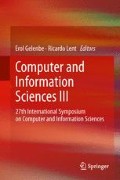Abstract
The great challenge in handling the security and resilience in emergency situations is that threats will typically affect more than one infrastructure. A fire is not only a direct hazard for people but it will also short the electrical system, cutting off the lights and possibly the communications and sensor infrastructure and even create more fires. The Tsunami in Japan in 2011 flooded the nuclear reactors but also cut of the pumps that were designed to respond to any flooding situations. This paper is part of a project that addresses these cascaded failures and studies them via simulation. To provide some quantitative estimates of the effect of such cascaded threats, we use the Distributed Building Evacuation Simulator (DBES) to represent the effect of a hazard (in this case a fire) which destroys the sensor system which is used to compute the best advice given to people that are evacuated during the fire. Our simulations compare the situation when the sensor system is intact, and also when it is compromised. As expected, some results highlight the poor overall system performance when the underlying infrastructures are damaged. However, in some scenarios, the degraded system appears to perform as well as the intact one. An analysis into the fault-tolerance of the system leads to some design guidelines which can be applied to design fault-tolerant systems.
Access this chapter
Tax calculation will be finalised at checkout
Purchases are for personal use only
References
Barnes, M., Leather, H., Arvind, D.K.: Emergency evacuation using wireless sensor networks. In: IEEE Conference on Local, Computer Networks, pp. 851–857 (2007)
Bruck, J., Gao, J., Jiang, A.A.: MAP: medial axis based geometric routing in sensor networks. In: ACM International Conference on Mobile Computing and Networking, pp. 88–102 (2005)
Chen, P.Y., Chen, W.T., Shen, Y.T.: A distributed area-based guiding navigation protocol for wireless sensor networks. In: IEEE International Conference on Parallel and Distributed Systems, pp. 647–654 (2008)
Chen, P.Y., Chen, W.T., Tseng, Y.C., Huang, C.F.: Providing group tour guide by rfids and wireless sensor networks. IEEE Trans. Wirel. Commun. 8(2), 1276–1536 (2009)
Chen, P.Y., Kao, Z.F., Chen, W.T., Lin, C.H.: A distributed flow-based guiding navigation protocol in wireless sensor networks. In: International Conference on Parallel Processing (2011) (to appear)
Chen, W.T., Chen, P.Y., Wu, C.H., Huang, C.F.: A load-balanced guiding navigation protocol in wireless sensor networks. In: IEEE Global Telecommunications Conference, pp. 1–6 (2008)
Cherniak, A., Zadorozhny, V.: Towards adaptive sensor data management for distributed fire evacuation infrastructure. In: International Conference on Mobile Data, Management, pp. 151–156 (2010)
Filippoupolitis, A., Gelenbe, E.: A decision support system for disaster management in buildings. In: Summer Computer Simulation Conference, pp. 141–147 (2009)
Filippoupolitis, A., Gelenbe, E.: A distributed decision support system for building evacuation. In: IEEE International Conference on Human System, Interactions, pp. 320–327 (2009)
Fischer, C., Gellersen, H.: Location and navigation support for emergency responders: a survey. IEEE Pervasive Comput. 9(1), 38–47 (2009)
Gelenbe, E.: A unified approach to the evaluation of a class of replacement algorithms. IEEE Trans. Comput. C-22(6), 611–618 (1973)
Gelenbe, E.: Steps towards self-aware networks. Commun. ACM 52, 66–75 (2009)
Gelenbe, E., Hébrail, G.: A probability model of uncertainty in data bases. In: ICDE, pp. 328–333. IEEE Computer Society (1986)
Gelenbe, E., Hussain, K., Kaptan, V.: Simulating autonomous agents in augmented reality. J. Syst. Softw. 74(3), 255–268 (2005)
Gelenbe, E., Sevcik, K.C.: Analysis of update synchronisation algorithms for multiple copy data bases. IEEE Trans. Comput. C-28(10), 737–747 (1979)
Gelenbe, E., Stafylopatis, A.: Global behavior of homogeneous random neural systems. Appl. Math. Model. 15, 534-541 (1991)
Gorbil, G., Gelenbe, E.: Opportunistic communications for emergency support systems. In: International Conference on Ambient Systems, Networks and Technologies, pp. 1–9 (2011)
Hu, F., Xiao, Y., Hao, Q.: Congestion-aware, loss-resilient bio-monitoring sensor networking for mobile health applications. IEEE J. Sel. Areas Commun. 27(4), 450–465 (2009)
Kaptan, V., Gelenbe, E.: Fusing terrain and goals: agent control in urban environments. In: Dasarathy, B.V. (ed.) Multisource Information Fusion: Architectures, Algorithms, and Applications, vol. 6242, pp. 71–79. SPIE (2006)
Li, M., Liu, Y., Wang, J., Yang, Z.: Sensor network navigation without locations. In: IEEE INFOCOM, pp. 2419–2427 (2009)
Li, Q., Rosa, M.D., Rus, D.: Distributed algorithms for guiding navigation across a sensor network. In: ACM International Conference on Mobile Computing and Networking, pp. 313–325 (2003)
Liu, H., Wan, P., Jia, X.: Maximal lifetime scheduling for sensor surveillance systems with k sensors to one target. IEEE Trans. Parallel Distrib. Syst. 17(12), 1526–1536 (2006)
Malan, D.J., Fulford-Jones, T.R., Nawoj, A., Clavel, A., Shnayder, V., Mainland, G., Welsh, M., Moulton, S.: Sensor networks for emergency response: challenges and opportunities. IEEE Pervasive Comput. 3(4), 16–23 (2004)
Pan, M.S., Tsai, C.H., Tseng, Y.C.: Emergency guiding and monitoring applications in indoor 3D environments by wireless sensor networks. Int. J. Sens. Netw. 1(1/2), 2–10 (2006)
Preparata, F.P., Shamos, M.I.: Computational Geometry: An Introduction. Springer, New York (1985)
Terrestrial ecology observing systems, center for embedded networked sensing. http://research.cens.ucla.edu/
Tseng, Y.C., Pan, M.S., Tsai, Y.Y.: Wireless sensor networks for emergency navigation. IEEE Comput. 39(7), 55–62 (2006)
Tubaishat, M., Zhuang, P., Qi, Q., Shang, Y.: Wireless sensor networks in intelligent transportation systems. Wirel. Commun. Mob. Comput. 9(3), 287–302 (2009)
Author information
Authors and Affiliations
Corresponding author
Editor information
Editors and Affiliations
Rights and permissions
Copyright information
© 2013 Springer-Verlag London
About this paper
Cite this paper
Desmet, A., Gelenbe, E. (2013). Interoperating Infrastructures in Emergencies. In: Gelenbe, E., Lent, R. (eds) Computer and Information Sciences III. Springer, London. https://doi.org/10.1007/978-1-4471-4594-3_13
Download citation
DOI: https://doi.org/10.1007/978-1-4471-4594-3_13
Published:
Publisher Name: Springer, London
Print ISBN: 978-1-4471-4593-6
Online ISBN: 978-1-4471-4594-3
eBook Packages: EngineeringEngineering (R0)

